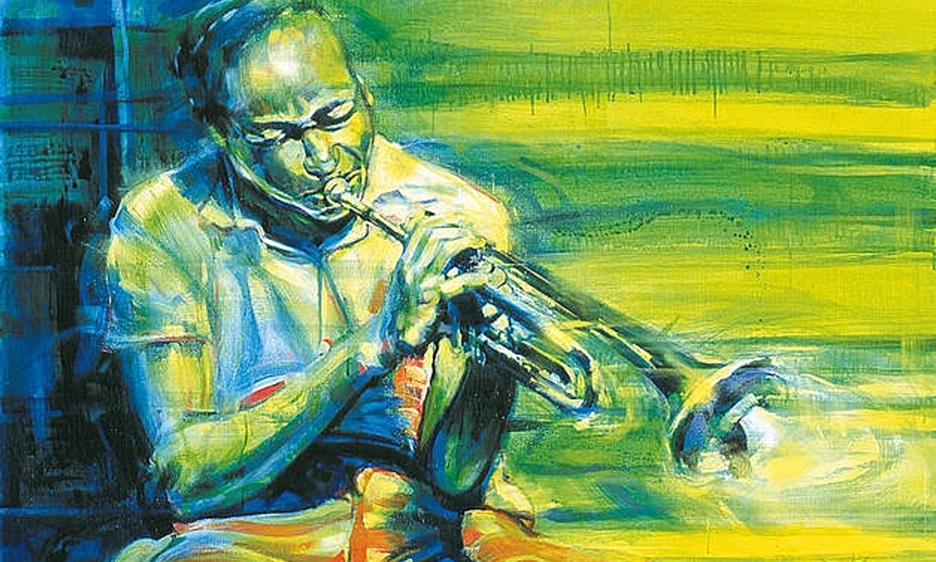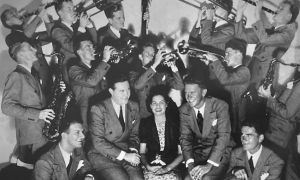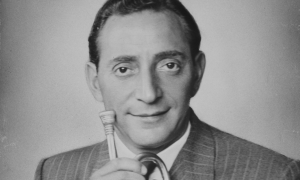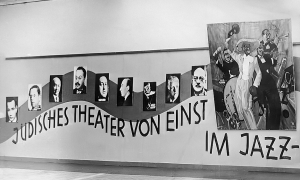Home » Jazz Articles » History of Jazz » Clifford Brown’s Trumpet and One Summer in Atlantic City
Clifford Brown’s Trumpet and One Summer in Atlantic City

Courtesy Franz Mandigers
He was just like a shooting star: he’s there and he’s gone.
—Sonny Rollins
For 22-year-old trumpeter Clifford Brown, the summer of 1953 in Atlantic City, New Jersey, was transformative. Playing with bebop elders, he cumulatively opened the door for what came next: a groove-oriented swinging style, in which small groups used structured arrangements like big bands, with room for improvisation, but less frenzy. It became known as hard bop, or "mainstream."
In early June, Brown went to New York City at the call of Tadd Dameron. Dameron planned a summer at the Club Paradise in Atlantic City's black Northside neighborhood as a rebirth from one of his several absences lost to drug use. For all his personal struggles, Dameron's music was consistently melodious; his arrangements were said to make eight or nine musicians sound like twenty. He had been a musical arranger for big bands of Jimmie Lunceford and Coleman Hawkins in the 1930s, and a composer and one of the chief arrangers for orchestras and bebop bands of the 1940s. "Hot House," "Lady Bird," and "Good Bait" were among his bebop classics, and, later, "On a Misty Night" with John Coltrane.
Dameron imagined Atlantic City as the incubator for better things, innovations upon show tunes while playing behind a revue of dancers, showgirls, and comedians. There would be time for more serious numbers to lead off and jam sessions after hours, even as the night stretched toward breakfast. He liked mentoring younger musicians, his conceptions for a multipiece ensemble interested Brown, and they began working together toward recording and summer performances.
First Notice
Brown began the year with a Philadelphia rhythm and blues dance band, Chris Powell and the Blue Flames. Brown never devalued that training; it schooled him in the life of a working musician. As a teenager Brown had obtained the notice of bebop masters Charlie Parker, Dizzy Gillespie, Roy Haynes, and Fats Navarro in Philadelphia. Even good players arriving there quickly learned they were only one among many. One veteran of the period, Billy Root, remembered "When you came to Philadelphia, you'd better be hot because they come out after you." Jazz, bebop, and R&B players had significant contact and crossover, and Brown had been heard.He was identified as having something special. As he matured, he could articulate every note even at high tempos without difficulty, enhancing the impression of speed, and express himself deeply in ballads. His sound was brilliant, warm and round, "fat" even, like that of trumpeter Fats Navarro who had influenced him, and consistent across the full range of the instrument. He had a gift for improvisation, endurance and durability without cracking, and lyrical warmth.
Brown had an indefatigable appetite for practice that never left him. His hometown of Wilmington, Delaware had a segregated school system, but there was great focus and support within the black community on the resources available, and dedicated educators. A high school music teacher, Harry Andrews, brought the discipline of having directed an army band and advanced university study. He provided after-hours tutoring for the eager student. A local sage, Boysie Lowery, taught the European musical tradition but also an analytic system for improvisation based on hearing and anticipating the chord movements of bebop. This was Brown's foundation.
City Within a City
Atlantic City had long been a place for jazz players to tune up on the outskirts of New York City. The music of the "Chocolate Kiddies" revues of bandleader Sam Wooding that in the 1920s first introduced jazz to many cities in Europe originated in cabarets in Atlantic City and Newark in advance of club dates in Times Square and Harlem.Atlantic City is right on the ocean, and although it has a beach, and boardwalk, it was never any kind of low-key beach town. From the initiation of its development in the late 1800s, it was always a city. By the 1950s it was fully urban, with buses and taxis, stone and mortar hotels facing the ocean and lining side streets, backed by residential neighborhoods. Philadelphia is less than a 100 miles away, Manhattan just more than a 100. Before there was air travel, railroads brought visitors from throughout the near northeast as Americans learned to vacation. Hard labor was necessary to build the city and service its hotels.
Situated in southern New Jersey, Atlantic City was a place for black people to land immediately upon leaving the South. The Mason-Dixon Line conceptually separating North from South ran along the borders of Pennsylvania and Delaware, states adjoining New Jersey. For black people moving up the East Coast, there was work in Harlem and work in Atlantic City, so both of those places were magnets for employment. Atlantic City needed its black residents to build and service the vacation place, and a parallel city flourished for them on the "Northside," an economy with its own services, professionals, and nightclubs, like the Club Paradise and Club Harlem.
Black people were segregated onto their own beach, after white guests had complained to private hoteliers about mixed usage of their beachfront. A city-owned stretch of sand between the ocean and the government-built Convention Hall became black people's own place of enjoyment. They turned back the derogatory name "Chicken Bone Beach" by claiming it with pride and an affirming identity. A whole network of small hotels, rooming houses, and guest cottages on the Northside welcomed black visitors, listed in the Negro Travelers' Green Book, and transportation companies facilitated daytrippers with dedicated bus routes.
One can imagine having been alive in Atlantic City then, spending the day at the beach, walking the boardwalk, returning to a hotel or lodging house pre-air conditioning, taking a nap on an iron-frame bed while salty rustling ocean breezes set the curtains in gentle motion, then showering and getting dressed to go out to a kind of Cotton Club, a "sepia revue" as Club Harlem's neon sign announced, amid the shifting codes of northern segregation, a parallel universe in the black part of town.
North Kentucky Avenue with the Club Harlem was the center of the Northside entertainment community. Club Paradise was just a few block away on North Illinois, and the musicians visited each interchangeably, especially for afterhours jam sessions. These were black clubs, with black management, black entertainers, and mostly a black clientele, but for all the separation on the beaches these were also places where the races mingled. The music was so popular that people began to care less about color and more about just having a good time, according to Cheryl Woodruff-Brooks who published a photographic retrospective of Atlantic City's black beach and nightlife scene.
Nelson Johnson, author of Boardwalk Empire that inspired the HBO television series, wrote in his history The Northside: African Americans and the Creation of Atlantic City that there was a kind of cooperation between black and white worlds that existed separately and together within the same 48 blocks. Atlantic City needed, and profited from, the commerce that black people drew to their own businesses. There was a necessity that everyone succeed at varying levels for overall economic benefit and growth. Black people were mostly left to live their own lives, based upon hotel service positions, but also supporting commercial and professional services within their own community. To Nelson, the black community was indispensable. "If you remove the black experience from Atlantic City, the town never even comes to exist. Pull them out of the picture and what do you have? You don't have a resort."
One Star Ascending
Amidst the preparatory work with Dameron before the move to Atlantic City, Lou Donaldson, an altoist in the style of Charlie Parker, also coveted Brown, and featured Brown in a June 9 session for Blue Note Records, New Faces—New Sounds Vol.2. With them were Elmo Hope, piano; Percy Heath, bass; and Philly Joe Jones, drums. Two days later, an organized Tadd Dameron Orchestra recorded four of his compositions as A Study in Dameronia for the Prestige label. The Orchestra was nine pieces: Dameron on piano; Brown, Heath, and Jones; Gigi Gryce on alto saxophone and Benny Golson on tenor, and three other players on brass and reeds. In swinging arrangements, Brown matches well in the ensemble. His solos soar, as sampled on the track "Choose Now."Dameron's band started strong at the Club Paradise. An octet of somewhat reconfigured personnel went to Atlantic City after the Prestige date: the core of Tadd Dameron, Clifford Brown, Gigi Gryce, Benny Golson, and Philly Joe Jones; with Johnny Coles also on trumpet, Jymie Merritt on bass, Cecil Payne on baritone saxophone. Johnny Coles recalled it to Brown biographer Nick Catalano in Clifford Brown: The Life and Art of the Legendary Jazz Trumpeter as "a poppin' little band... made up of all jazz musicians... a complete show," with dancers and show girls. "It ran every night, seven days a week." Quincy Jones came up on a visit just to listen from Wildwood, a beach resort below Atlantic City where he had been playing with Lionel Hampton, was astounded by Brown's playing, and went back to Hampton begging him to hire Brown for an impending autumn tour of Europe.
On a Monday after opening at Club Paradise, Brown made a quick trip up from the Jersey shore to Rudy Van Gelder's studio in Hackensack for a June 22 recording date for another Blue Note release. The Eminent Jay Jay Johnson, an alternate spelling for trombonist and leader J.J. Johnson, listed Brown's name listed atop the other sidemen: Percy Heath again on bass; Jimmy Heath on tenor and baritone saxophone; John Lewis on piano, and Kenny Clarke on drums. That group included three-fourths of what would become the Modern Jazz Quartet: Percy Heath, John Lewis, Kenny Clarke, missing only Milt Jackson on vibes.
Brown had stepped up into exalted company, in which he excelled. Jimmy Heath recalled to biographer Catalano the richness and variety of Brown's inventions in solos across several takes for the Johnson session. Many musicians could play fast, Heath knew, but were limited in constructing inventive lines. Brown kept dishing out new bursts of creativity.
Before the end of the summer, August 28, Brown created his own sextet for an album New Star on the Horizon, as Blue Note anointed him. He called upon people he had worked with earlier that summer: Gigi Gryce on alto sax and flute, Percy Heath again on bass; John Lewis, piano, with the addition of Charlie Rouse, tenor; and Art Blakey on drums, who he had jammed with in Philadelphia. That made four major label releases featuring Brown for the summer, three on Blue Note and one on Prestige. He had been backed by two of the key rhythmic architects from the bebop era, drummers Philly Joe Jones and Kenny Clarke, and Art Blakey from the next generation. In the next year would come an important association with another bebop mainstay, drummer Max Roach, whose influence would continue into the next decades.
Dameron's vision, however, was not to last. Philly Joe appeared to have brought drug habits with him, and that affinity put a fright into Dameron, disrupting the band. As the Dameron effort collapsed, Brown did go with Lionel Hampton, from August to December in a trumpet section that included Quincy Jones and Art Farmer, arriving in Europe at the beginning of September. Clifford recorded there with Hampton and in a variety of breakout sessions under his own name with local European musicians and Hampton sidemen seeing extracurricular work.
Benny Golson stayed behind to assist Dameron in completing the summer, but it was a damaged and disappointing effort. Dameron retreated into narcotics again, disappearing back to his home haunts of Cleveland, Ohio for another lost period. Drugs would continue to bedevil him over the years, but it would be Clifford Brown and Max Roach who pulled him out of Cleveland in 1956 to return with them to New York where they were scheduled at the club Basin Street East, with a new member, saxophonist Sonny Rollins. Dameron contributed and arranged two compositions. One, "The Scene is Clean," stated the session's drug-free aspirations. Dameron's life is detailed more fully in the biography Dameronia: The Life and Times of Tadd Dameron by Paul Combs. (Read our coverage).
Drugs presented no enticement to Clifford Brown; he was scrupulously clean in an era where players thought heroin was the necessary gateway to jazz heights explored by Charlie Parker. Brown's example had impressed upon Sonny Rollins, fresh from rehab at a federal prison hospital in Lexington, Kentucky, that it was possible not to take drugs and still be a jazz musician of the first order. "Clifford was a profound influence on my personal life," Rollins stated. "He showed me that it was possible to live a good, clean life and still be a good jazz musician."
Opportunity Terminated
Upon Clifford's return from Europe, he began work with Art Blakey toward live recordings in February 1954, A Night at Birdland, Vol. I and II. Those sessions became landmarks, heralding the birth of what would become Blakey's Jazz Messengers and modern jazz for decades to come. By mid-year, Brown went to the West Coast at the invitation of Max Roach, who had liked Brown's work on the J.J. Johnson recording.Clifford Brown's light burned brightly but briefly, illuminating a new direction that might have changed the entire arc of subsequent jazz. Many believe Brown was a better player than Miles Davis, in technique, speed, tone, and range. Miles was never particularly fast over extended runs, nor known for sustained high notes. That Brown does not have the renown of Miles Davis is certainly due in part to Davis' innovative genius, but also because of Miles had a longer life in which to create.
Clifford was denied that. Three years after that summer in Atlantic City, on another night in June, Brown died a passenger in an automobile accident en route from Philadelphia to Chicago. He was 25. Sonny Rollins had recorded his major work Saxophone Colossus just days before Clifford's death, with Max Roach in the drum seat. Rollins and Roach individually stayed up alone and grieving through the night at the news of Clifford's death, Rollins playing out his pain through his horn, Roach drinking through the dark hours.
Harold Land, the original saxophonist with the Roach and Brown quintet, remembered that many of their contemporaries wondered that a man so young in years as Brown could acquire such command, depth, and broad musical scope in such a relatively short span of time. They called him a "young old man:" playing with the fire and creativeness of a young man, and with the depth, tenderness, and insight into past, present, and future of an older man.
Rollins felt the spark of creativity in the Brown/Roach alliance die with Clifford: "He was just like a shooting star: he's there and he's gone." Kenny Dorham substituted in on trumpet, competent but not as luminous as Brown. Rollins moved on to his own work, but rejoined Roach, and Dorham, into 1957-58 for a semblance of the original group.
With Brown's death, Miles Davis was the remaining dominant trumpeter. How much more might Brown have been is one of the great unknowables of jazz. It is possible that Miles and Clifford might have each created two separate streams of jazz, Clifford brighter and joyous, Miles intense and moody; two different personalities, two different avatars.
What Might Have Been?
The liner notes for Verve's Master Edition re-issue of the EmArcy Clifford Brown and Max Roach state speculation about what Brown might have achieved had he lived is "pointless." That assertion is qualified with a "however": that based on the legacy Brown left behind, "there is no doubt that his contributions would have immeasurably enriched not just the standards for his instrument, but the whole of jazz."Even though Brown is from an earlier period now almost seventy years ago, his playing still sounds fresh, and is not merely archival. It is not avant-garde nor free jazz nor fusion nor the iterations that followed. The clarity of Lee Morgan, Freddie Hubbard, Woody Shaw, Wynton Marsalis, and now Jeremy Pelt continues the heritage of Clifford Brown.
A documentary film by music professor Don Glanden, Brownie Speaks, considers Brown's placement. (Read our coverage) Wynton Marsalis praised Clifford as proof of the power of the art form of jazz trumpet itself. Trumpeter and educator Donald Byrd said Brown created a new vocabulary for the instrument, by advancing playing technique and style. Dizzy Gillespie, an innovator of bebop with whom Miles played in the late 1940s, weighed in that Brown was to have been the next major voice in the evolution of trumpeters. Roy Eldridge, a bridge between swing to bebop, declared "As good as he was, he was going to be better."
Some question whether Brown would have been as innovative as Davis, but overlook the innovations of which Brown had already been a part. Certainly, refining hard bop out of bebop was an innovation. Brown was present at the birth of hard bop, the 1954 Birdland sessions of Art Blakey and Horace Silver out of which came Blakey's Jazz Messengers. He had already been signed to the groundbreaking Blue Note label.
Davis and Brown came up through the same time in the early 1950s, but began in different eras. Miles had been a member of Parker and Gillespie groups in the late 1940s; Clifford caught just a few encounters with them. At every point, being six years older, Miles had a head start, and after Clifford's death more time in which to keep working, with his "Prince of Darkness" persona and the marketing support of Columbia Records.
For all that, they were comparable within the same time frame, running alongside each other even if not in direct competition. Both appeared at the 1955 Newport Jazz Festival. The Brown/Roach quintet was a Saturday headliner, Clifford only 24 years old. Davis, age 30, was a Sunday afternoon add-on; his legendary "Round Midnight" performance restored his standing after years of drug-related wandering and earned him the Columbia contract.
That same year, Brown recorded an orchestral album with Neal Hefti, who had been an arranger for Count Basie and Woody Herman. Miles with a nine-piece group had recorded what became Birth of the Cool in 1949 under arrangements by Gil Evans, but not until 1957 did Davis record again with the Gil Evans Orchestra, and then not again until 1960 with Sketches of Spain.
Within the same time period, Brown and Davis had similar repertoires, both conventional in nature but each innovative in their respective styles. Clifford offered such as "Someone to Watch Over Me," "I Get a Kick Out of You," "One for my Baby," and "Love Is a Many Splendored Thing," romantic, bright, with a range extending to smooth highs that Miles rarely sustained. The albums Workin', Cookin', Relaxin' and Steamin' that Miles generated in 1955 revisited bebop classics "Salt Peanuts" and "Well You Needn't," Broadway show tunes "It Never Entered My Mind" and "If I Were a Bell," and popular standards such as "When I Fall in Love" and "My Funny Valentine." On all of those Miles albums, the drummer was Philly Joe Jones, the same as on Brown's early recordings.
Would Kind of Blue have been assembled in 1959 without a living Miles? Would Herbie Hancock, Wayne Shorter, Ron Carter, Tony Williams have coalesced as they did without a Miles to bring them together? Similarly, the subsequent history of those who played with Clifford Brown, for all their accomplishments, whether they changed the direction of jazz or simply became greater expressions of themselves, cannot accurately estimate what might have been accomplished with Brown's unifying presence and leadership. His departure was a loss.
Listening across the many samples of Brown's works, there is a characteristic purity to his sound. Signature songs are "Joy Spring," "Daahoud," and both his trumpet and Roach's drum solos on "Cherokee." His pairing with saxophonist Harold Land on "Delilah" is impeccable for each. Brown's early work from A Study in Dameronia and some of the European recordings made during the Lionel Hampton tour, originally under the title Clifford Brown—Art Farmer and the Swedish All Stars, are contained in the reissue compilation Clifford Brown Memorial Albums by Prestige/Original Jazz Classics. The sessions under Lou Donaldson and Brown's leadership in 1953 both are contained in the different but similarly-titled Memorial Album by Blue Note. Many reissues present the work with Max Roach, among them Study in Brown (EmArcy), and Clifford Brown and Max Roach (EmArcy/Verve). The period with Sonny Rollins, and Dameron's arrangements, is documented in Clifford Brown and Max Roach at Basin Street (EmArcy/Verve); also, with different material, on Sonny Rollins Plus 4 (Prestige). Later-discovered rehearsal sessions from the early sessions with Dameron through later with Roach are contained on Clifford Brown: The Lost Rehearsals 1953-1956 on the European RLR label. Enthusiasts can go deeper for other available live, outtake, and rehearsal material.
Wilmington, Delaware for 34 years has remembered its son with the Clifford Brown Jazz Festival, now with additional related concerts throughout the year. Atlantic City's Chicken Bone Beach Historical Foundation has created a music teaching facility on the Northside, keeping the spirit alive. It also presented concerts throughout the year in the grand Claridge Hotel of the Boardwalk Empire era, and weekly concerts on Thursday evenings in July and August on the boardwalk at Missouri Avenue, the site of the old segregated beach. The concerts, and the beach, are open to anyone.
Tags
History of Jazz
Clifford Brown
Arthur R George
United States
New Jersey
Atlantic City
New York City
Tadd Dameron
Jimmy Lunceford
Coleman Hawkins
John Coltrane
Philadelphia
Charlie Parker
Dizzy Gillespie
Roy Haynes
Fats Navarro
Wilmington
Sam Wooding
Newark
Lou Donaldson
Elmo Hope
Percy Heath
"Philly Joe" Jones
G.G. Gryce
benny golson
m; Johnny Coles
Jymie Merritt
Cecil Payne
Quincy Jones
Lionel Hampton
J.J. Johnson
Jimmy Heath
John Lewis
Kenny Clarke
Milt Jackson
Charlie Rouse
Art Blakey
Max Roach
Art Farmer
Sonny Rollins
Miles Davis
Saxophone Colossus
Harold Land
Kenny Dorham
Donald Byrd
Roy Eldridge
Neal Hefti
Count Basie
Woody Herman
Gil Evans
PREVIOUS / NEXT
Support All About Jazz
 All About Jazz has been a pillar of jazz since 1995, championing it as an art form and, more importantly, supporting the musicians who make it. Our enduring commitment has made "AAJ" one of the most culturally important websites of its kind, read by hundreds of thousands of fans, musicians and industry figures every month.
All About Jazz has been a pillar of jazz since 1995, championing it as an art form and, more importantly, supporting the musicians who make it. Our enduring commitment has made "AAJ" one of the most culturally important websites of its kind, read by hundreds of thousands of fans, musicians and industry figures every month.
























